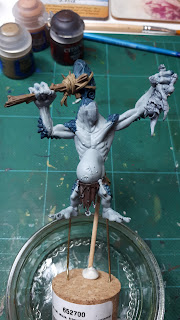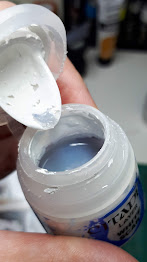Troggoth Painting Skin Guide

As I am currently unable to get hold of a webcam due to them being snapped up by everyone working from home, I thought I would try and do a blog post on how I paint skin. Following up on my earlier post on the technical side of things with the Sara bust I painted, this is how I go about it. Using the troggoths that I have been painting recently my process can be summed up in a few steps: 1) lay down a good base coat, in the troggs case, this was Celestial Grey 2) sketch in the shadows This is probably one of the main steps. As this is where I establish where my shadows and highlights are going to go and will set me up for the rest of the painting. Using my own mix of Navy Blue ( scale colour), Naggroth Night and Magos Purple, I sketched in where I wanted the shadows to be: As you can see this stage is pretty messy, as I'm using a very thinned paint in order to establish the values I need on the mini. Don't feel disheartened at this point as you are going to tidy it up!









